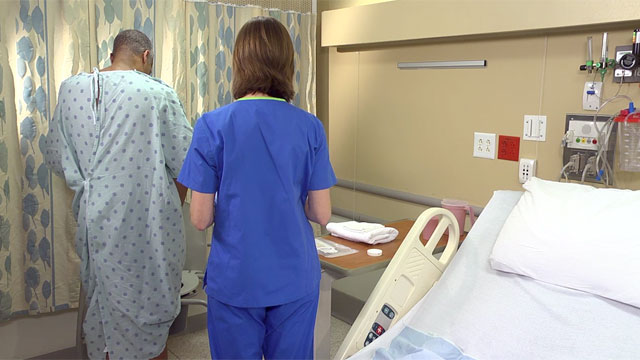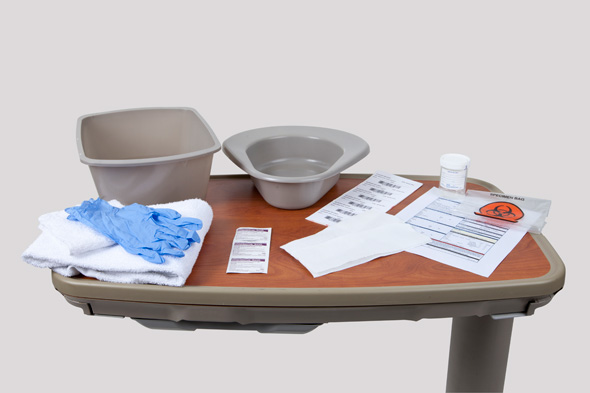Specimen Collection
Select a Skill:
- » Collecting a Midstream Urine Specimen
- » Performing Fecal Occult Blood Testing
- » Performing Gastric Occult Blood Testing
- » Collecting a Sputum Specimen
- » Collecting a Specimen for Wound Culture
- » Performing Blood Glucose Testing
- » Screening Urine for Chemical Properties
Take the Review Test:

Safety
- Follow standard precautions when collecting a specimen of blood or body fluid, and take any additional precautions for collecting specimens from patients who are in protective isolation.
- Properly label all specimens with the patient’s identification, the date and time the specimen was obtained, the name of the test, and the source of the specimen.
- Be aware that culture and sensitivity (C&S) testing of urine is performed to identify if bacteria are present (culture) and, if so, to determine the antibiotic to which the bacteria are most vulnerable (sensitivity).
- Use sterile technique to ensure that any microorganisms present originate in the urine, and not from the patient’s skin or hands, or from the environment.
- Understand that cleansing the perineum before collecting a specimen prevents contamination of the specimen after the urine passes from the urethra. Specimen contamination is the most common reason for inaccurate reporting on urine culture and sensitivity tests.
Equipment
(Roll cursor over items to see labels)

Identification labels with patient identifiers
Laboratory requisition form
Sterile specimen container
Small plastic biohazard bag
Antiseptic wipes
Clean gloves
Washcloth and towel
Basin
Bedpan
Delegation
The skill of collecting urine specimens can be delegated to nursing assistive personnel (NAP). Be sure to inform NAP of the following:
- Specify when to obtain the specimens.
- Review any mobility restrictions the patient has that will affect the collection technique.
- Direct that you be notified if the urine is not clear, for example, if it contains blood, is cloudy, or has excessive sediment.
- Direct that you be notified when a patient is unable to initiate a urine stream or has pain or burning on urination.
Preparation
- Assess the patient’s or the family members’ understanding of the purpose of the test and the method of collecting the specimen.
- Assess the patient’s ability to assist with urine specimen collection, including the ability to position himself or herself and hold the specimen container.
- Assess the patient for signs and symptoms of a urinary tract infection (UTI), including frequency, urgency, dysuria, hematuria, flank pain, fever, or cloudy, malodorous urine.
- Refer to your agency’s policy regarding methods of specimen collection.
Follow-up
- Evaluate the patient’s urine culture and sensitivity (C&S) report to determine whether it was positive for bacterial growth.
Documentation
- Record the collection of a specimen according to your agency’s policy.
- Note the method by which the specimen was obtained; the date and time it was collected; the type of test ordered; the appearance, odor, and color of the urine; and the disposition of the specimen to the laboratory.
- Report any abnormal findings to the health care provider.
Review Questions
1. After bacteria are cultured from a midstream urine specimen, what is accomplished by sensitivity testing?
 Confirms the accuracy of the results of the culture
Confirms the accuracy of the results of the culture Identifies the immune system’s reaction to the presence of the bacteria
Identifies the immune system’s reaction to the presence of the bacteria Determines whether the patient is allergic to the antibiotic agent with which the provider plans to treat the infection
Determines whether the patient is allergic to the antibiotic agent with which the provider plans to treat the infection Determines which antibiotic agent is most effective in killing the bacteria
Determines which antibiotic agent is most effective in killing the bacteria
2. What can the nurse do to help ensure an accurate result when collecting a midstream urine sample for a patient who is menstruating?
 Notify the health care provider.
Notify the health care provider. Make a note on the lab slip that the patient is menstruating.
Make a note on the lab slip that the patient is menstruating. Postpone the specimen collection until menses has ceased.
Postpone the specimen collection until menses has ceased.  Do nothing other than follow normal procedure, since menstruation will not affect the results.
Do nothing other than follow normal procedure, since menstruation will not affect the results.
3. Which statement might the nurse make to nursing assistive personnel (NAP) assigned to collect a midstream urine specimen from a patient with signs of a urinary tract infection?
 “Obtain 30 to 60 mL of midstream urine.”
“Obtain 30 to 60 mL of midstream urine.” “The urine has a foul odor.”
“The urine has a foul odor.” “Teach the patient to collect the urine specimen.”
“Teach the patient to collect the urine specimen.” “Be sure to maintain aseptic technique.”
“Be sure to maintain aseptic technique.”
4. Which statement might the nurse make to nursing assistive personnel (NAP) in order to help ensure reliable results of culture and sensitivity testing of a midstream urine specimen?
 “I’ll need a biohazard bag to put the specimen into.”
“I’ll need a biohazard bag to put the specimen into.”  “Please get the specimen to the lab within 20 minutes.”
“Please get the specimen to the lab within 20 minutes.”  “After you replace the cap, please wipe any drops of urine from the outside of the container.”
“After you replace the cap, please wipe any drops of urine from the outside of the container.” “We are out of specimen collection kits.”
“We are out of specimen collection kits.”
5. What is the most important action the nurse can take to ensure that a midstream urine specimen does not become contaminated?
 Wear sterile gloves to open the sterile specimen kit.
Wear sterile gloves to open the sterile specimen kit.  Ensure that the patient’s perineum has been cleansed before the specimen is obtained.
Ensure that the patient’s perineum has been cleansed before the specimen is obtained. Determine if the patient has any known allergies.
Determine if the patient has any known allergies. Have the patient rate his or her current pain level.
Have the patient rate his or her current pain level.
You have completed the Review Questions for this skill. To take the Review again select the Start Over button. To proceed to another skill select from the dropdown menu. Select the Home or Back button to proceed to the next section.

